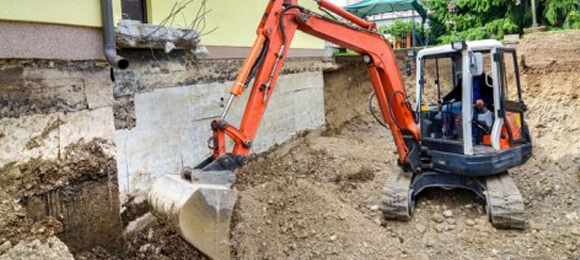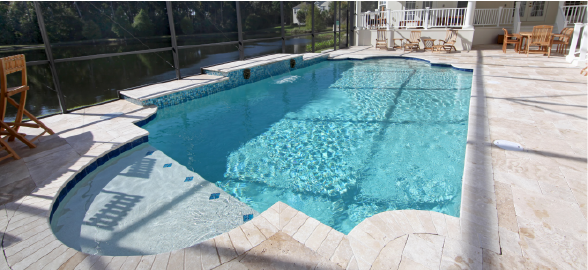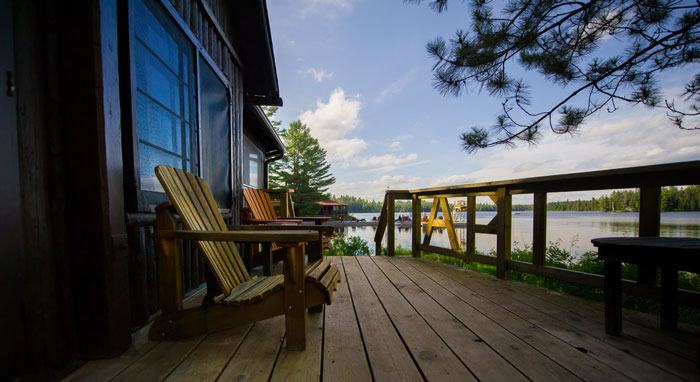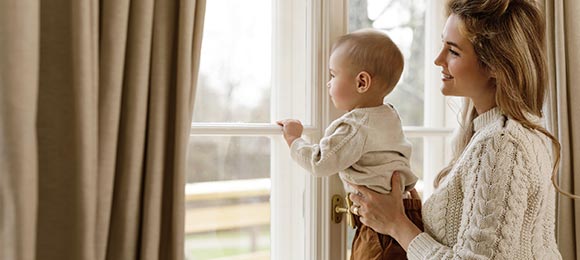
Updated April 11, 2023
Most contractors would agree that their busiest seasons are spring and summer. More people opt to do projects in mid to late April and throughout the summer simply because the warmer, drier weather makes it a better time to be outside, working on the home or in the yard, and getting things done. Because of this increase in projects, contractors' schedules tend to be busier and less flexible from April to September and more open and flexible between October and March. During slower months, building materials and labor costs are typically cheaper as well.
Tackling projects during the offseason can save you money and time, and is a great way to make good use of your time during the slightly slower, colder months. Regardless of how small or minor the updates may be, those small projects result in a huge impact.
Here are our top 8 picks for the best home improvement projects to tackle before the warm weather arrives:
- Maintain Heating System
- Change Out Batteries and Bulbs
- Add a Fresh Coat of Paint
- Replace Door and Cabinet Hardware
- Seal and Insulate As Needed
- Prep Your Landscaping
- Remove Old Structures
- Tackle a Small Remodel
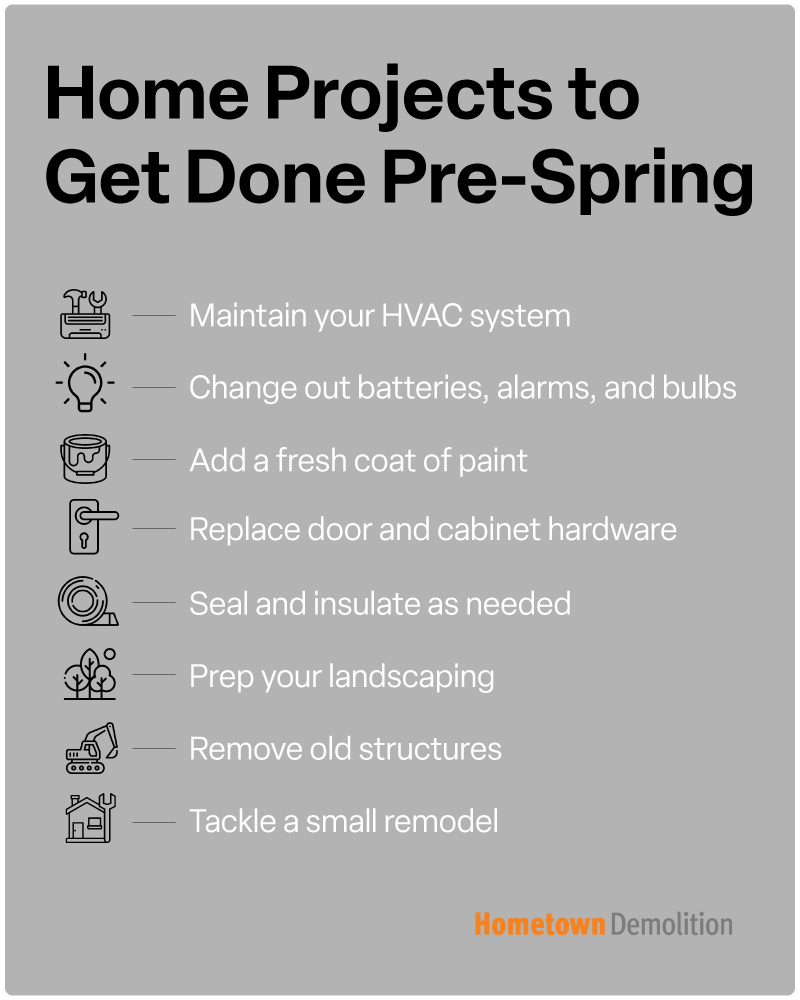
1. Maintain Your Heating System

Keeping up with your furnace's general maintenance is an easy project to do, especially during colder months when your home is closed up and you're indoors more often. With windows closed and the furnace going, it's important to replace your heating system filters at least every three months. If you have pets, smoke, use your fireplace, or have allergies, then you should replace your filters as often as once a month. Furnace filter replacements average $18-$40 on average. The cost of annual HVAC maintenance averages $75-$200. If your system needs extensive repairs, you may have to pay as much as $2,000-$3,000.
These costs may cause you to hesitate or put this project on the back burner, but The National Association of Realtors reports that HVAC remodels have a more than 70% ROI, which is a higher return on investment on average than most other types of remodeling projects. HVAC repairs and replacements can increase homes value by up to 10%.
2. Change Out Batteries and Bulbs

Similarly to swapping out furnace filters, make sure all your smoke alarms and carbon monoxide detectors have working batteries. Replace any alarms that have a built-in lithium-powered battery and have outlived the date listed on the back. In most cities, fire departments provide a free replacement service, so reach out to yours before going to the trouble yourself. Along the same lines, we recommend swapping out your existing lightbulbs with LED options if you haven't already done so. These are energy efficient and longer lasting, saving you money.
The average cost to upgrade lightbulbs is $4-$20 per bulb. If you need assistance installing new lightbulbs, you can expect to pay $20-$50 on average for labor. This minor investment of new lightbulbs goes a long way in making your home look lighter, brighter, bigger, and newer. On top of that, the added safety and efficiency that comes with replacing bulbs, batteries, and alarms cannot be overstated.
3. Add a Fresh Coat of Paint

Paint is one the most inexpensive ways to transform a space, and it can transform nearly anything. Your walls are just the beginning. You can paint cabinets, panelling, garage floors, basement floors, and everything in between. Because there is less moisture and humidity in the air during the cooler months, paint dries faster and bonds to surfaces better and stronger. Use a fan to ventilate the area you're painting in and encourage air circulation.
Costing $15-$50 per gallon on average, paint's cost is a small investment in the big payoff it provides. Painting you home's boasts a 107% ROI on average, and painting the home's exterior is a worthwhile ROI of 55%. Not to mention, painting can have a huge impact on how you view your home and how you feel in it.
Keep reading:
- How to Fall in Love with Your Home Again
- How to Remodel Your Basement On a Budget
- Bedroom Remodeling: The Basics You Should Know
- Hire the Right Remodeling Contractor and Know What to Expect
4. Replace Door and Cabinet Hardware

Another great project with a big effect is replacing the hardware on the doors throughout your home and the cabinets in your kitchen and bathroom(s). Purchasing in bulk can give your entire home a new look and feel without breaking the bank. Another nice thing about this project is it can be done over the weekend in a matter of hours. And when it's all said and done, the difference can be remarkable.
The cost to swap out hardware is $20-$300 on average per piece but can also be quite a bit more depending on the materials you choose and how many hardware fixtures you're replacing. Upgrading hardware fixtures averages a 75-100% ROI, so this is a worthwhile project in more ways than one.
Learn more:
- Save Money by Remodeling Your Kitchen or Bath This Winter
- Recycle Demolition and Remodeling Debris to Save Money and Protect the Environment
5. Seal and Insulate as Needed

Sealing leaks around your home's windows, doors, vents, and in the attic where air seeps in and out can reduce airflow by 25% and save you 11% on total energy costs. Not only does this save you money as a homeowner, but these eco-friendly improvements appeal to new homebuyers, too, now more than ever. For roughly $400, you can have a home energy auditor out to your home to assess each room and identify solutions for making it as energy-efficient as possible. However, you can easily do your own energy audit of sorts to check for drafts, air leaks, gaps, etc.
Seal cracks with caulk or insulating spray foam to eliminate drafts and keep out moisture. Likewise, if you live in a cold region, an uninsulated attic is the fastest way to allow warm air to escape. An insulation contractor can help you determine where your home could benefit from insulating material and which type. The attic, foundation, and duct work are the most common areas. The average cost of home insulation is $3,000-$10,000 for a 2,000 square foot home or $1.50-$5.00 per square foot. This is an investment, but the cost to upgrade or re-insulate a house can pay for itself in a matter of years thanks to reduced electrical bills.
6. Prep Your Landscaping

If you live where temperatures drop, winter is typically too cold to fertilize your lawn, but it's a great time to assess your trees and shrubs. February and March are the two months when tree removal is the least expensive. Not only are companies less busy during this time, but the frozen ground makes tree removal less disruptive to surrounding areas and vegetation.
7. Remove Old Structures

Similar to prepping your landscaping, the cold months, right before spring, is a great time to remove exterior structures that are worse for wear. Pools, fences, decks, barns, garages, and concrete can all be removed in the winter. Doing so can increase your property value and save you money on project costs.
Deck or Patio
There's nothing quite like a deck or patio, and most homeowner or homebuyers would agree. If your wood deck is old and falling apart or simply boring and empty, or if your concrete patio is sunken or damaged, removing it or replacing it is an easy and relatively inexpensive way to boost your home's value.
Professional deck removal is a great option for people who don't have the experience, physical strength, or safety equipment needed to rip up boards and nails, or those who simply don't want to handle the laborious work. The average cost of professional deck removal is $600-$1,000, including debris disposal. Professional patio removal is quick and not that different from the cost of deck removal in many cases. The average cost of patio removal is $300-$2,400. Patios are usually less expensive, and therefore have a higher resale value of 100%, compared to a deck's 76% ROI.
Keep reading:
- Deck Trends That Create the Ultimate Backyard Living Space
- What You Should Know About Removing a Concrete Patio Attached to a House
Driveway
If your home was built in the 1980s or earlier and has its original driveway, it's time to consider removal and replacement. Removing and replacing a driveway instantly makes your property look newer and more beautiful while also increasing your home's safety and your overall enjoyment of it.
Professional driveway removal costs $1,500-$3,000 on average, but your driveway removal cost will depend on the size of the driveway and whether or not the driveway was built with reinforced concrete, in which case the cost to remove it will increase. Complete driveway replacement costs $6,000-$12,000 on average. While this is an investment, you can expect a 50% ROI on average and an increase in your home's value.
Fence
Removing a damaged or old fence can instantly make you love your yard again as well as increase your property value. On average, professional fence removal costs $600-$800. Fence replacement costs $4,000-$8,000 on average, including fence removal and installation. Fence replacement can also recoup up to 50% of these costs, which is enjoyable in itself to know, but the safety and privacy a fence provides is priceless.
Read on:
- Wood vs Vinyl Fencing: Which Is the Right Fence for You?
- Do Fences Increase a Home's Property Value?
- Can You Recognize the 5 Signs of a Bad Fence?
Pool
Upgrading or removing your pool could be a great way to increase your home's value. If you upgrade it, you'll have a beautiful pool that you can enjoy for years to come. And if you live in a neighborhood where pools are common and expected, then having one is definitely going to increase your home's value and give you a great return on investment. If you live in an area that freezes in the winter or pools aren't that common where you live, then removing it may be the best choice from a property value standpoint.
Inground pool removal costs $5,000-$7,500 on average, with inground pool replacement costing $20,000-$30,000 on average. Above ground pool removal costs $1,000-$3,000 on average, with above ground pool replacement costing $3,000-$5,000 on average.
Outbuilding
If you have an old outbuilding sitting on your property, remove it with the help of a professional outbuilding demolition company. The average cost of shed demolition is $600-$2,000. With a freshly cleared yard, you can utilize the space for even more enjoyable things, from a new garden to a fire pit or area for lawn games.
If your outbuilding is still in good condition but just needs a little attention, organize and declutter it, give it a little paint, or add lighting for functionality to make your outbuilding look like a whole new structure with only a little effort.
Keep reading:
- Get Rid of Your Old Shed to Make Way for the New
- It Pays to Have Your Barn Demolished
- Will Demolition Increase Your Property Value?
8. Tackle a Small Remodel

When it comes to updating your home, it doesn't have to be "all or nothing." Take things one room at a time, and don't put pressure on yourself to do everything at once. Interior demolition contractors' costs are typically lower outside of the busy spring and summer months, and they can help you get a head start on whatever your ultimate vision is. Gutting out your entire bathroom and starting fresh is one option, but so is only removing your bathtub and replacing it with a shower pan instead. You could remove your old cabinet structure and replace it with a modern, free-standing model.
The average cost of a small bathroom remodel is $1,000-$3,000, with the average ROI being 80%. The average cost of a small kitchen remodel is $2,000-$5,000, with a 60-70% ROI on average.
Learn more: Create a Home Remodeling Plan in 10 Simple Steps
